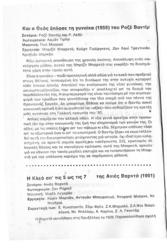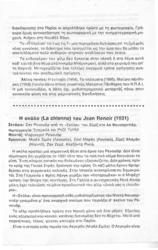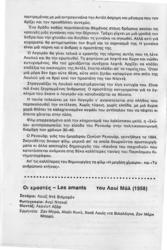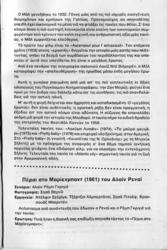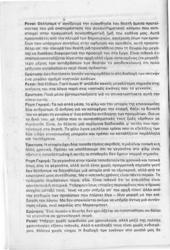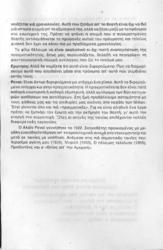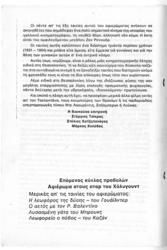Program
ΤΑΙΝΙΟΘΗΚΗ ΤΗΣ ΕΛΛΑΔΟΣ & ΓΑΛΛΙΚΟ ΙΝΣΤΙΤΟΥΤΟ (Θεσσαλονίκη) - WOMAN'S MYTH AND FRENCH CINEMA
Programme of the Greek Film Archive Foundation in cooperation with the French Institute and the Thessaloniki Film Club entitled "THE MYTH OF WOMAN AND THE FRENCH CINEMA". The venue is the French Institute and the programme will last from December 1982 until January 1983
There are credits and reviews for the 5 films on the programme:
1. "AND GOD CREATED WOMAN" (1956), directed by Roger Vadim.
Sex, eroticism at reasonable doses and a new face are the recipe of this huge box office success, which shot Brigitte Bardot to stardom and identified her with similar roles for the rest of her career. The heroine embodies a young "petit-bourgeois woman who decides to break free from the constraints of her social environment". It is about a woman who is still a child on the inside, clearly seductive but innocent all the same.
2. "CLEO FROM 5 TO 7" (1961), directed by Agnes Varda
The brief note begins with a concise reference to the female director's biography, how she started out as a photographer and ended up as a director. She properly belongs to the Nouvelle Vague movement. The appealing aspect of the film, which is an account of 2 hours in the life of a woman before she has the results of serious medical examinations, is not in the subject itself but rather the way it is handled and the use of a narrative that seems to lack a proper beginning. Reference is also made to her filmography, including "LE BONHEUR" (1954), "THE CREATURES" (1966) and "BLACK PANTHERS" (1968).
3. “THE BITCH” (1931) by Jean Renoir.
The brief note begins with the statement that the film, an adaptation from a novel by De la Fouchardière, is made in 1931, a year of great significance: in the U.S., the Wall Street breakdown is just over, in Spain democracy is declared, in Germany the Nazis triumph in the German elections, while Fritz Lang makes his film “M” and Brecht writes “THE THREE-PENNY OPERA”. The note includes a detailed description of the film’s plot: the main character is a married cashier, who gets involved in a love affair with a whore. The film is considered a “populist drama reflecting the director’s engagement in the social conflict spanning 1930-1940”. Of particular interest is the remark that cinema halls were reluctant to screen the film, because it had enraged the general public. A brief presentation of the biography and the rest of the director’s filmography follow, with the emphasis on the films: “THE GRAND ILLUSION” and “THE HUMAN BEAST”.
4. “THE LOVERS» (1958) by Louis Malle.
The note begins by providing brief information on Louis Malle’s biography and on the first film he directed, the “ASCENSEUR POUR L’ ECHAFAUD” (1957). His next film, “THE LOVERS”, an adaptation of a book by "high-society" author Louise de Vilmorin, tells the story of a bourgeois, played by Jean Morreau, who, even though she is married, gives in to a great but "sinful" love. The film won the special critics' award at the Cannes Festival in 1958. Finally, the note mentions the late filmography of the director: “LACOMBE, LUCIEN” (1974), “BLACK MOON” (1975), "PRETTY BABY” (1978) and “ATLANTIC CITY”.
5. “LAST YEAR AT MARIENBAD” (1961) by Alain Resnais
The note features long extracts from the interview with director Alain Resnais and scriptwriter Alain Robbe-Grillet about the film: their main intention was to reflect the viewer’s emotional world. To this end, they tried to remove anything that might impede narration, on condition that the viewer would rise to such a challenge. The succession of facts in time and in space is not of particular importance in order to follow the story, given that the director intends to tell a story through the inner world of conscience. The constant sense of ambiguity as well as the fine line between what happens inside the characters and what takes place in the real world give the film its various different possible meanings. The note closes by briefly informing on the director’s biography and filmography, highlighting the films: “HIROSHIMA, MON AMOUR” (1959), “MURIEL” (1963), “THE WAR IS OVER” (1965), “MY AMERICAN UNCLE”.
The last paragraph of the eight-page note about the retrospective of “The Myth of Woman and the French Cinema” summarizes the program’s intention to depict, through four films by French directors who represent the Nouvelle Vague movement and the controversial Jean Renoir, the woman’s position in a span of thirty years (1931-1964). Expressing the pressing need for a film club in Thessaloniki, to counteract the capital’s centralization, the next series of screenings is announced, a retrospective dedicated to Hollywood stars, and there is a list of some representative film titles: “SUNSET BOULEVARD” by Wilder, “THE EAGLE” with Valentino, “CAT ON A HOT TIN ROOF” by Brooks, “A STREETCAR NAMED DESIRE” by Kazan.
- Cinema ΤΑΙΝΙΟΘΗΚΗ ΤΗΣ ΕΛΛΑΔΟΣ & ΓΑΛΛΙΚΟ ΙΝΣΤΙΤΟΥΤΟ (Θεσσαλονίκη)
- Tribute WOMAN'S MYTH AND FRENCH CINEMA
- Pages 8
- Language GREEK, MODERN (1453 - )
- Height 29,5 CM
- Width 21 CM
- Paper Type ΒΙΟΜΗΧΑΝΙΚΟ
- Status ΠΟΛΥ ΚΑΛΗ




